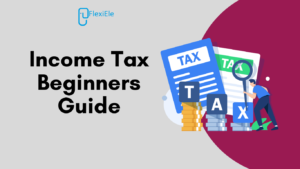
Understanding income tax is a fundamental aspect of financial literacy, yet it often evokes confusion for many, especially those just starting their journey into the world of personal finance. Income tax is not just an obligatory financial duty; it is also a multifaceted system that helps fund public services, infrastructure, and government initiatives. This blog post aims to demystify the essentials of income tax, providing beginners with a clear framework to understand its significance, structure, and implications.
What is Income Tax?
Income tax is a tax levied by the government on the income generated by individuals, businesses, corporations, and other entities.
Who Is Liable to Pay Income Tax?
In India, any individual who earns an income above a specified threshold is taxed according to the provisions of the Income Tax Act. The tax structure is progressive, meaning that higher incomes are taxed at higher rates. The current income tax slabs can vary based on factors such as the individual’s age and residential status.
Some Types of Income Taxpayers
-
Individuals:
This category includes members of the general public, including salaried employees, self-employed individuals, and professionals.
-
Hindu Undivided Family (HUF):
A separate entity recognized under Indian law; an HUF can also be liable for income tax.
-
Companies:
Corporations are taxed differently from individuals, with distinct tax rates based on their type (domestic or foreign).
-
Firms:
A partnership firm is also classified as a taxable entity under the Income Tax Act.
Previous Year vs. Assessment Year
Two key terms are crucial in understanding the Indian tax system: the previous year and the assessment year.
-
Previous Year
This is the financial year in which the income is earned. In India, the financial year runs from April 1 to March 31 of the year. For example, for the assessment year 2024-25, the previous year is from April 1, 2023, to March 31, 2024.
-
Assessment Year
This is the year following the previous year when the income earned is assessed and taxed. The assessment year allows the government to calculate how much tax is owed by the taxpayer for the income earned in the previous year. For instance, for the previous year 2024-25, the assessment year will be 2025-26.
Understanding Salary and Tax Implications
Salaried individuals form a significant portion of the taxpayer demographic in India. Salary refers to the remuneration received by employees from their employers for their services. In India, the salary can be broadly classified into three components:
-
Basic Salary
The fundamental component of the salary structure, upon which various allowances are based and other components are calculated.
-
Allowances
Additional payments made to employees to cover specific expenses or for fulfilling particular responsibilities. Common allowances include House Rent Allowance (HRA), Conveyance Allowance, and Medical Allowance.
-
Perquisites
Non-cash benefits provided to employees, which can include benefits such as company vehicles, accommodation, or stock options.
Understanding the complete salary structure helps individuals assess their taxable income accurately. Several deductions might apply, reducing the overall taxable amount, including Sections 80C, 80D, and others that cater to investments, education, health insurance, among others.
Sources of Income
Income tax in India is applied to various sources of income, which can be broadly classified into five categories:
-
Income from Salary:
This is the income earned by individuals through their employment. It includes basic salary, allowances, and bonuses.
-
Income from House Property:
This includes rental income derived from property owned by the taxpayer.
-
Income from Business and Profession:
Profits earned from business operations or professional services are taxable under this category.
-
Capital Gains:
This refers to profits earned from the sale of capital assets such as stocks, bonds, and real estate.
-
Income from Other Sources:
Any other income not categorized under the previous sources, like interest income from savings accounts or fixed deposits, falls under this category.
Income Tax Slabs According to the Recent Budget
India employs a progressive taxation system, which means that higher incomes are taxed at higher rates. The income tax slabs can vary each financial year, typically announced during the Union Budget. Below is a simplified overview of the income tax slabs for individual taxpayers for the financial year 2023-24:
Old Tax Regime
| Income Tax Slab | Individuals Below the age of 60 | Senior Citizens of age Above 60 below 80 | Super Senior Citizens of Age Above 80 |
| Up to 2,50,000 |
NIL |
NIL
|
NIL
|
| Senior Citizens up to 3,00,000 | |||
| Super Senior Citizens up to 5,00,000 | |||
| 2,50,000 to 5,00,000 |
5% |
5% |
NIL |
| Senior Citizens 3,00,000 to 5,00,000 | |||
| 5,00,000 to 10,00,000 | 20% | 20% | 20% |
| 10,00,000 And Above | 30% | 30% | 30% |
New Tax Regime
Introduced as an alternative taxation option, the new tax regime offers lower tax rates but limits the exemptions and deductions available under the old regime 2025-26:
| Income Tax Slabs | Tax Rate |
| Up-to Rs. 4,00,000 | NIL |
| Rs. 4,00,001 – Rs. 8,00,000 | 5% |
| Rs. 8,00,001 – Rs. 12,00,000 | 10% |
| Rs. 12,00,001 – Rs. 16,00,000 | 15% |
| Rs. 16,00,001 – Rs. 20,00,000 | 20% |
| Rs. 20,00,001 – Rs. 24,00,000 | 25% |
| Above Rs. 24,00,000 | 30% |
Income tax slabs are periodically reviewed and revised, usually during the annual budget announcement. This allows the government to respond to changing economic conditions, inflation, and the financial needs of the populace. With the upcoming Budget 2025, there is considerable anticipation regarding potential adjustments to these tax slabs. Stakeholders are keenly interested in how these changes might alleviate the tax burden on middle-class taxpayers or provide incentives for higher earners, reflecting the current economic landscape and the government’s fiscal strategies.
How FlexiEle Can help in managing Tax for Organizations and Employees?
Managing tax for each employee can be a task. So, there are various payroll software solutions available in the market to help organizations streamline the tax process. One of the best software solutions among them is FlexiEle.
- If any employee has any issue regarding their tax process, FlexiEle efficiently resolves employee queries through its online helpdesk.
- FlexiEle’s payroll system includes diverse payroll components, benefits, and taxes.
- FlexiEle ensures adherence to minimum wages, perquisites, and statutory deductions.
Conclusion
Understanding the basics of income tax in India is crucial for effective financial management and compliance. While the tax structure can initially appear complex, beginners can simplify their understanding by familiarizing themselves with tax slabs, types of income, deductions, and the process for filing returns. Keeping abreast of changes in tax laws and rates is also crucial, as this can impact your tax liabilities from year to year.

